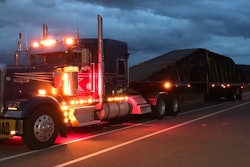Winslow Bent, founder of Legacy Classic Trucks, has always had a passion for collecting vehicles that are attached to a particular moment in time.
Picking from his own collection with the holidays and cold weather fast approaching, Bent unveiled a well-kept and extraordinarily functional 1942 Ford Marmon-Herrington four-wheel drive SnoGo in his newest episode of the YouTube series, This Old Truck.
 Legacy Classic Trucks founder Winslow Bent pulled this 1942 Ford Marmon-Herrington SnoGo out of his collection in time for the holidays.
Legacy Classic Trucks founder Winslow Bent pulled this 1942 Ford Marmon-Herrington SnoGo out of his collection in time for the holidays.
“This machine is such a cool piece of history for the snow plowing industry and it's amazing it still runs as well as it does. That just goes to show the exceptional craftsmanship that went into building something like this all these years ago,” comments Bent. “With the snowy weather and the holidays right around the corner, I knew it would be a great time to pull this machine out and show everyone what it is truly capable of in the winter months.”
 This 1942 Ford Marmon-Herrington SnoGo has many sleek features including the blower that attaches to the front bumper of the truck. The blower consists of three augers which are large blades that rotate inside the snow blower housing and break up any enormous chunks of snow in its path.
This 1942 Ford Marmon-Herrington SnoGo has many sleek features including the blower that attaches to the front bumper of the truck. The blower consists of three augers which are large blades that rotate inside the snow blower housing and break up any enormous chunks of snow in its path.

Behind the rotating augers is a fan attached to the chute on the side of the loader. As the snow enters the augers, the fan shoots it over the side of the snow banks to create tall sheer walls commonly seen on highways during the winter months. Bent explains that because this machine works extremely hard to get the snow off the main roads, it tends to get very warm inside the cab. In the past, it was very common to see these SnoGo operators in the dead of winter take the doors off the vehicle given the lack of ventilation to deal with this extreme built up heat.
“On a highway, you would use this 1942 Ford SnoGo for the sides of the roads where snow keeps piling up making the roads narrower and narrower,” Bent added. “These SnoGo’s were crucial when the snowplows were no longer able to get the snow up on the banks. A telltale sign that the SnoGo has been there are the sheer walls that could be from 3 feet up to 8 feet of snow.”
 What helped these SnoGo’s continue through large snow banks is the upgraded four-wheel drive system from Marmon-Herrington.
What helped these SnoGo’s continue through large snow banks is the upgraded four-wheel drive system from Marmon-Herrington.
Additionally, the 1942 Ford SnoGo used to be a standard 2-ton Ford truck with the cab and engine in the front until Marmon-Herrington’s four-wheel drive systems were put into place to give these machines more stability and strength when plowing the highways.
 1942 Ford Marmon-Herrington SnoGo is outfitted with a rear 501 cubic inch international Red Diamond straight 6 gas engine. The fuel tank on this vehicle is gravity fed, meaning it aggressively dumps fuel into the engine at a fast rate given that the SnoGo can plow straight into a snowbank and go from having no load to immediately working hard to keep the machine running at 2,000 RPMs throughout.
1942 Ford Marmon-Herrington SnoGo is outfitted with a rear 501 cubic inch international Red Diamond straight 6 gas engine. The fuel tank on this vehicle is gravity fed, meaning it aggressively dumps fuel into the engine at a fast rate given that the SnoGo can plow straight into a snowbank and go from having no load to immediately working hard to keep the machine running at 2,000 RPMs throughout. The truck is currently only used on private property, given the technological advancements of modern SnoGo’s, but in the past these trucks were responsible for clearing public roads in small towns when the snow banks would get too tall for regular snow plows.
The truck is currently only used on private property, given the technological advancements of modern SnoGo’s, but in the past these trucks were responsible for clearing public roads in small towns when the snow banks would get too tall for regular snow plows.













